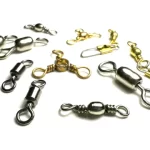How many times have you made a cast, reeled in your slack line, and then all of a sudden you feel a bump, then BAM! You try to set your hook but you miss the fish? Sound familiar? Trust me; this happens to anglers all the time. I can’t tell you how many times this occurs, especially while observing my 3-day students and charter clients. Most of them just can’t figure out why they keep missing fish when they’re getting the strikes. Don’t feel bad if this sounds like you, but I was also an angler that did exactly the same thing for many years, in fact I was probably the worst at pre-setting a hook.
Setting the hook to early and missing fish don’t just happen when fishing plastics on the bottom either. How many times have you thrown a top water lure, then all of a sudden a fish jumps on it and you JERK THE ROD! Just to miss the fish again. Hey, it happens all the time, especially on the surface because it’s visual and probably the most exciting way to fish for bass.
There are certain times when using different baits that you want to set the hook immediately, and then on the other side of the coin, there are certain times when you don’t want to set the hook too quickly.
Since top water fishing is the most exciting to most anglers I will start with this type of fishing. One of my favorite top water baits happens to be a Zara Spook. In my opinion, this bait is probably one of the best “big bass” baits that has ever been made.
Setting The Hook Too Soon
Problem: Unfortunately, the only problem that I use to have with this bait is that I would make a cast, watch it hit the water, then as soon as it hit the water, immediately a fish would jump all over the bait, (before I even had a chance to start working it), and seeing this happen I would immediately SET THE HOOK. Wow, I can’t even try to tell how many fish I would lose by doing this.
Remedy: Now, after several years and hundreds of fish missed by doing this I finally realized what I was doing wrong. I was just too impatient and way too quick on the draw when it came to setting the hook. I found that if you let the fish take the bait and wait until you feel the pressure of the fish before setting the hook you won’t loose a fraction of the fish that you would miss otherwise. This technique will apply to most all top water baits including poppers, prop baits, floating worms, jerk baits (hard and soft), and the best of all of course, the Zara Spook. Now, the exception to this rule is when using certain baits such as a buzz bait, sometimes frogs (while swimming), or any action baits that you normally would work with a steady motion in which case you would set the hook quickly.
Next, we will cover the “in-between” sub surface, but not bottom types of baits like the spinner bait, crank bait, swimming plastics, and action baits.
Crankbaits
First, let’s cover a crankbait. I have missed a good many fish in the past while fishing a crankbait because I wanted to set the hook too quickly — nothing wrong with that. What I didn’t realize was that I wasn’t using the right tool for the application. What I mean when mentioning the right tool is that I was using a rod that was too stiff, and when I would try to set the hook I would usually miss the fish because I didn’t have enough flex in my rod causing the bait to break loose.
You have to remember that most crank baits have little treble hooks, and these hooks don’t allow a lot of penetration. So after losing many fish over the years fishing crank baits I finally thought to myself ‘DUH! Use a more flexible rod’.
I decided to get myself a very flexible rod for fishing a crankbait with those little treble hooks on them, (they do make rods, especially for crank baits), and the problem was solved.
Spinnerbaits
Spinnerbaits are a story of their own. When fishing a spinnerbait, keep in mind that it normally has only one hook, and usually the hook is a big one. This means that when fishing with a spinnerbait and using the “Chunk and Wind”, or cast and retrieve technique, when you feel a fish hit the bait you need to SET THE HOOK! Do it quickly to penetrate the hook into the fish for a good hook set.
The best rod for this type of application is a medium heavy action with some backbone. When using lighter action rods with single hook baits, the stronger set the better because the lighter actions have much more flexibility and you need to penetrate the hook as best as you can. Now, most anglers prefer the “Chunk and Wind” technique when using a spinnerbait, but what they don’t know is that a spinnerbait can be worked at least six ways very successfully other than just the “Chunk and Wind” technique. A couple of these techniques really don’t require a very quick set, but again that’s another story.
Plastic Baits And Action Baits
When swimming plastic baits and using action baits with single hooks, again, use a stiffer type of rod and set as soon as you feel a strike. Action baits along with spinnerbaits and swimming plastics are all quick reaction bites and you usually won’t get another chance to set once a fish grabs it.
Bottom Fishing Baits
Plastic worms, crawls, centipedes, just to name a few, are normally fished with single hooks either Texas rigged, Carolina rigged, Mo-Jo rigged, Mo-Wak rigged (which happens to be my own technique I came up with), the Drop Shot rig and the Wacky rig. This means once again that you may want a stiffer type of rod and a good hook set because of using the single hook.
The best way I learned to successfully set the hook using some of these baits is to let the fish put a little pressure on your line before setting the hook. This technique is where most of my former students and charter clients have had the worst time catching fish because they had a tendency to set very quickly as soon as they felt a bite. After teaching them to reel in the slack and lift the rod tip, just putting enough pressure to feel a fish, and then setting the hook, most of them have been much more consistent and successful at catching instead of missing the fish.
One very important thing I must mention is that when lifting your rod tip for the feel of the fish, NEVER! EVER! tip the rod down and back up when setting the hook. This causes a quick slack in your line and more times than not you will lose the fish.
All credit for this great article goes to Boat US. https://www.boatus.com/fishing/articles/when-to-set-the-hook.asp





